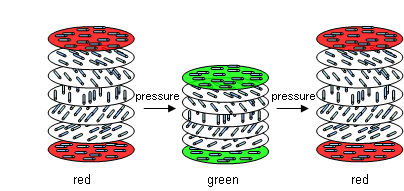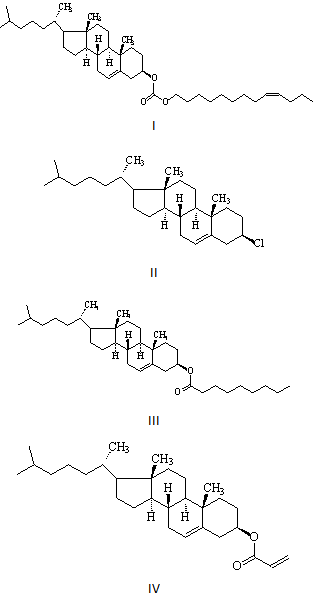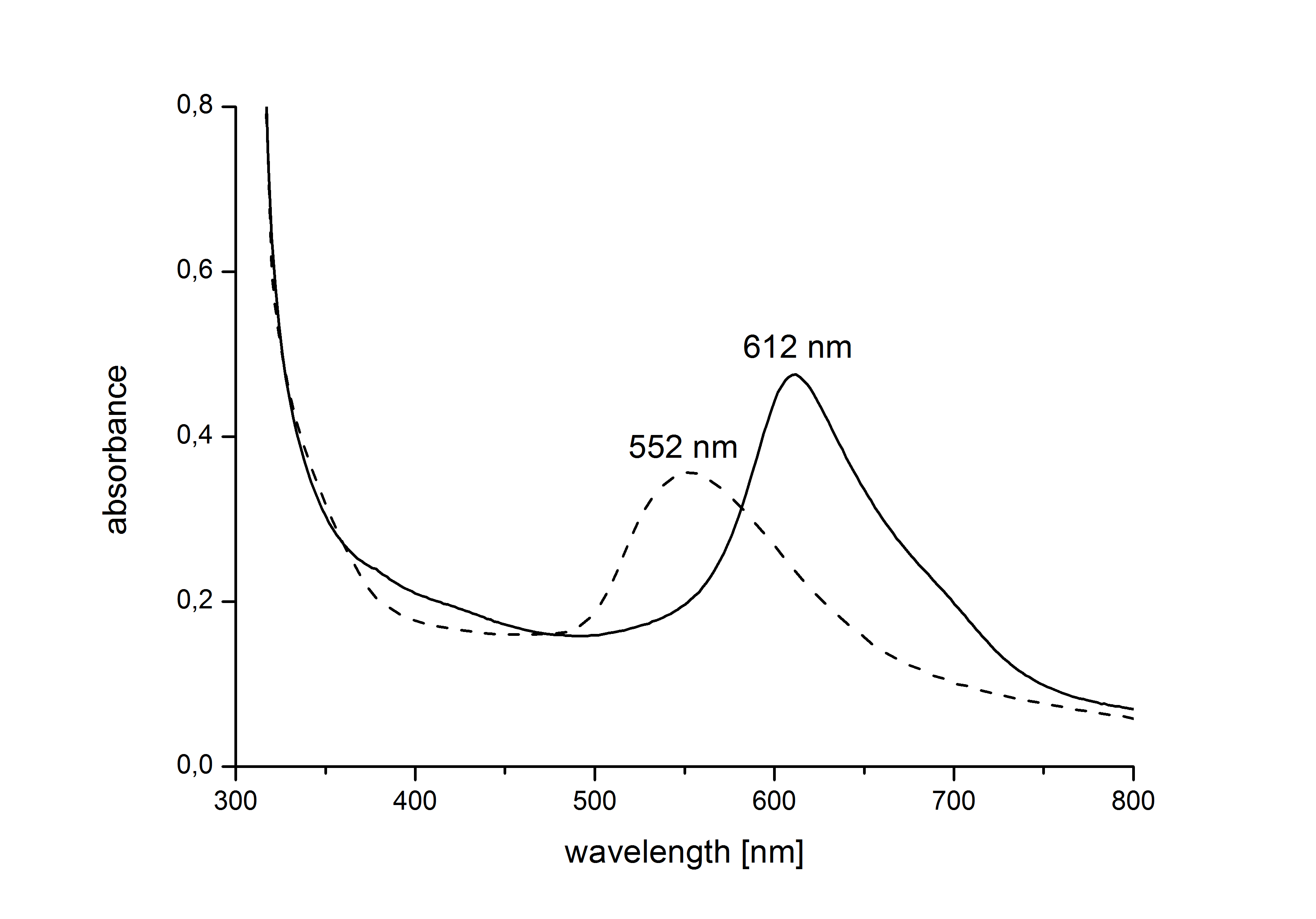-
Paper Information
- Next Paper
- Previous Paper
- Paper Submission
-
Journal Information
- About This Journal
- Editorial Board
- Current Issue
- Archive
- Author Guidelines
- Contact Us
American Journal of Materials Science
p-ISSN: 2162-9382 e-ISSN: 2162-8424
2011; 1(2): 139-142
doi: 10.5923/j.materials.20110102.23
Piezochromic Polymer Materials Displaying Pressure Changes in Bar-Ranges
Arno Seeboth , Detlef Loetzsch , Ralf Ruhmann
Fraunhofer Institute for Applied Polymer Research, Department of Chromogenic Polymers, Volmerstrasse 7 B, Berlin, 12489, Germany
Correspondence to: Arno Seeboth , Fraunhofer Institute for Applied Polymer Research, Department of Chromogenic Polymers, Volmerstrasse 7 B, Berlin, 12489, Germany.
| Email: |  |
Copyright © 2012 Scientific & Academic Publishing. All Rights Reserved.
A piezochromic material exhibiting a pressure dependent reversible shift of the selective reflection wavelength via the entire visible range is developed. The material consists of a cholesteric mixture embedded in a cholesteric elastomer matrix bearing mesogenic side chains with similar molecular structure. The change of the selective reflection has its origin in a compressible helix structure. Thus, the pitch length is switched by pressure changes. To trigger the reversible piezochromic effect already pressure changes in bar-range are sufficient. The pressure controlled colour changes are excellent detectable by the human eye and still appear even after 100 cycles.
Keywords: Piezochromic, Polymer, Selective Reflection, Pressure Sensor, Ordered Structure
Cite this paper: Arno Seeboth , Detlef Loetzsch , Ralf Ruhmann , "Piezochromic Polymer Materials Displaying Pressure Changes in Bar-Ranges", American Journal of Materials Science, Vol. 1 No. 2, 2011, pp. 139-142. doi: 10.5923/j.materials.20110102.23.
1. Introduction
- Piezochromic effects based on modification changes of inorganic crystalline materials, such as LiF or NaCl monocrystals, are known phenomena since several decades. For example, the transition from the green α- into the red γ-modification of CuMoO4 requires a pressure of 2.5 kbar and transitions in palladium complexes are reported to require pressures ranging from 1.4 to 6.5 GPa (=14 to 65 kbar)[1,2]. However, the high pressure which is necessary for the modification changes makes these materials unsuitable as pressure sensors in the ordinary area of life. Colour changes by pressure in organic polymer materials are frequently but not systematically described in literature so far. A bathochromic shift of the absorption band of poly (3-dodecylthiophene) was observed by increasing the pressure from atmospheric pressure to 8 kbar[3]. In reference[4] a bathochromic shift from 605 nm to 672 nm (Δλ = 67 nm) is reported for poly[3-(1-dodecyl) thiophene-2,5-diyl] when the pressure is increased from normal pressure to 10.71 GPa (=107.1 kbar). The piezochromic effect of these conjugated polymers is based on pressure dependent shifts of the absorption band. The aim of the present work was to develop piezochromic polymer materials exhibiting, for the first time, colour changes detectable with the human eye in dependence of pressure differences as small as a few bar. Such material could be used as an optical pressure sensor in the ordinary area of life. Our strategy is based on the knowledge about the preparation of cholesteric polymer materials with a selectivereflection in the visible range[5-8] and the possibility to tune the helical pitch and thus the selective reflection wavelength by stress[9,10]. The integra-tion of a cholesteric structure in a cross-linked polymer network with soft elastic properties should lead to the aimed piezochromic behaviour. Under pressure an elastic deformation of the helical pitch should appear resulting in a change of the selective reflection colour as shown in Figure 1.
 | Figure 1. Pressure-dependent changes of the selective reflection wavelength of a helical structure |
2. Experimental
- All chemicals were purchased from Aldrich and were used without further purification. Cholesterylacrylate (IV) was synthesised from cholesterol and acryloylchloride based on a procedure described in[7].The phase-transition temperatures were determined with a Perkin Elmer DSC7 at a heating rate of 5K / min. An Olympus BH-2 polarizing optical microscope equipped with a Linkam THMSE-600 hot stage was used to observe the phase-transition temperatures and to analyze the liquid-crystalline properties through the observation of the optical textures.The photopolymerisation was carried out by exposure with a Black Light lamp (Philips PL-S 9W/08) under Argon for 15 min.
3. Results and Discussion
- The investigation was started with an eutectic mixture of different cholesteryl derivatives, which exhibits a cholesteric phase with a selective reflection of red light at room temperature. The mixture is composed of the components cholesteryloleylcarbonate (I), cholesterylchloride (II) and cholesterylnonanate (III) with a ratio of 13.9:32.9:53.2 wt.-%.
 | Figure 2. Structure of the used Cholesteryl derivatives I – III and Cholesterylacrylate IV |
 | Figure 3. Photos of the piezochromic material mounted between two glass slides. A local change from red (a) to green occurs if an appropriate pressure is applied (b) |
 | Figure 4. UV/Vis spectra of a piezochromic film without () and under (--) pressure of 0.4 bar |
4. Conclusions
- The results are in agreement with the discussed scheme in Figure 1. The piezochromic effect is reversible and its switching time is in the second range. After 100 switching cycles no visible change of the piezochromic properties was observed.Compared to the known piezochromic organic materials based on conformational structure changes orders of magnitudes smaller pressure differences are sufficient for an eye detectable piezochromism[3, 4]. The high sensitivity and the low pressure working range of the presented material enable to construct a new kind of piezochromic pressure sensor suitable to display changes in the single-digit bar ranges or less. Furthermore, the combination of piezochromism with other chromogenic properties, especially thermochromic or thermotropic effects, could be lead to novel functional materials[14-17].The preparation of the presented piezochromic material is not a synthetic challenge and well reproducible.It can be expected, that other elastomers with helical structures exhibit a similar behaviour, if the interaction between the low molecular mass cholesteric phase and the polymeric backbone is strong enough. Analogous systems could be for example alkoxy- or alkyl- cyanobiphenyls in combination with 4-acryloyloxy-4’-cyanobiphenyl as photopolymerisable monomer and a chiral dopant for the adjustment of the cholesteric pitch.
 Abstract
Abstract Reference
Reference Full-Text PDF
Full-Text PDF Full-Text HTML
Full-Text HTML